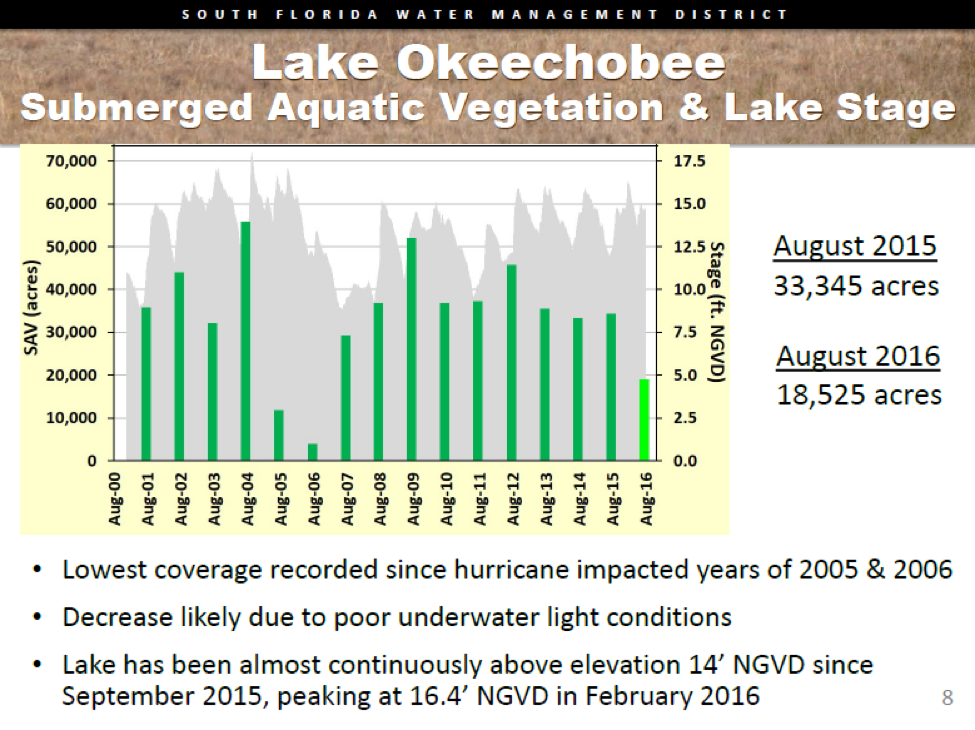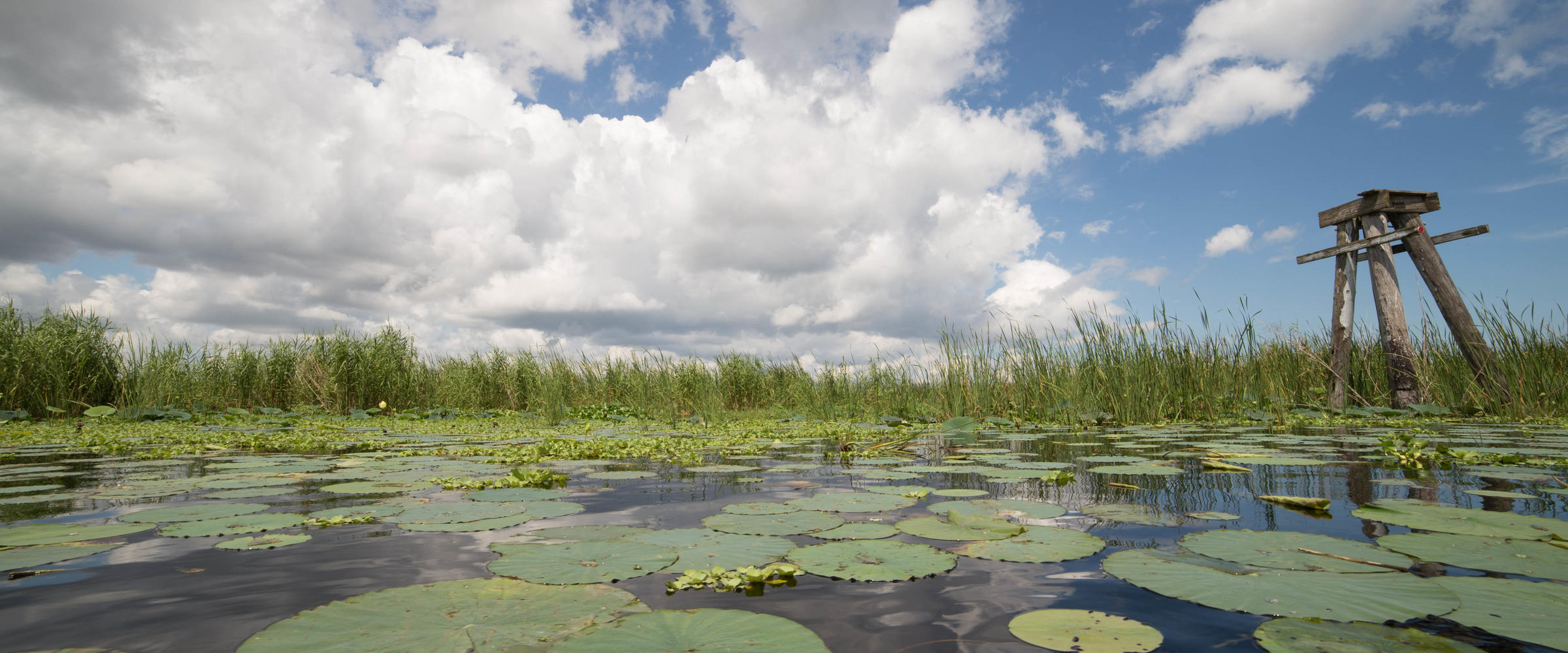By: Dr. Paul Gray
October 24, 2017
As the full impacts of Hurricane Irma on Florida’s natural ecosystems become known, it is clear that some of the most destructive effects will be on Lake Okeechobee. Audubon has already reported that according to University of Florida biologists, 44 Everglade Snail Kite nests were destroyed by hurricane winds and high rainfall. But even greater damage to the lake’s ecosystem and Audubon’s Lake Okeechobee Sanctuaries are on the horizon as a result of the long-term impacts of deep dirty water.
The target range for Lake Okeechobee’s water levels is between 12.5 and 15.5 feet in order to protect ecological resources and the safety of the Herbert Hoover Dike that surrounds the lake. Lake Okeechobee is now above 17 feet- its highest level in more than a decade.
In the aftermath of Hurricane Irma, ongoing repairs to the earthen dike, an important safety project, have received a lot of attention. Despite there being no evidence that more water can be safely stored in the lake after repairs are complete, the dike rehabilitation is frequently misconstrued as a water storage project. But current conditions are demonstrating in real time the devastating ecological impacts of holding more water in Lake Okeechobee.
Deeper water means dirtier water for Lake Okeechobee
When water levels in Lake Okeechobee rise above 15.5 feet, light is blocked in the deepening water and plants in the 60 square mile wide submerged aquatic plant community begin to die. Submerged aquatic vegetation (SAV), like eel grass, hydrilla, peppergrass, and shrimpgrass, is found on the deep water edge of the marsh and grows below the surface. These plants help remove harmful nutrients from water in the lake. When these plants die in high water, the filtration benefits are lost, and water quality declines severely.
In 2016, lake levels rose above 16 feet for just one month, and the submerged aquatic vegetation dropped from 33,000 acres to 18,500 acres- a loss of more than 20 square miles of vegetation (Figure 1). By comparison, present stages above 17 feet will likely decimate the SAV habitat, which will take years to recover. The recent high water impacts to the SAVs are compounded by the impacts of Hurricane Irma’s winds which stirred up harmful nutrient-laden mud sediments from the bottom of the lake and made the water darker and more turbid.
High Lake Okeechobee stages can lead to even more harm to the St. Lucie and Caloosahatchee estuaries
The impact on the lake’s habitat is also bad for the St. Lucie and Caloosahatchee estuaries. Without additional options to store and flow water south from Lake Okeechobee, threats to the Herbert Hoover Dike necessitate discharges to these sensitive coastal estuaries. If this happens after the SAVs have been destroyed by high lake levels, the water being discharged is now dirtier than it would have been if the lake ecosystem was protected. The threat of algae blooms forming in the estuaries is increased with higher levels of nutrients in the discharged water. Holding water levels in Lake Okeechobee higher actually increases the chances of algae blooms forming in coastal estuaries.
Deeper water impacts recreational and economic benefits
The SAVs are also essential habitat for bass and crappie fisheries. When this habitat is lost because of high water levels, a fisheries collapse can be expected to follow. This was seen after the 2004-2005 hurricane seasons, when as now, high water levels impacted SAV. The crappie fishery, which can produce up to a million fish per year, crashed and did not recover for almost a decade. The world-famous bass fishery that hosts more than 500 fishing tournaments per year also crashed and could not recover until the submerged plants grew back many years later.
Lake Okeechobee’s Future
The key to recovering Lake Okeechobee from this recurring problem is to create additional options for water management throughout America's Everglades. Hurricane Irma has highlighted the urgency to increase the capacity to store water outside of Lake Okeechobee. This is why implementing projects like the Everglades Agricultural Area (EAA) Reservoir advanced by the Florida Legislature in Senate Bill 10 (2017) is so important. Some of the water that is harmfully piling up in the lake, and in turn being harmfully discharged to the St. Lucie and Caloosahatchee Estuaries, could instead be moved to new water storage infrastructure to protect all of these valuable ecosystems. The water that is stored can then be available for Floridians and the Greater Everglades Ecosystem when dry conditions return.
Holding more water in Lake Okeechobee year-round is not the answer and would have simply compounded the problems and challenges caused by Hurricane Irma. Rapid water level rise in the lake is a constant threat. Hurricane Irma has raised water levels in the lake by 3.5 feet in one month. Tropical Storm Fay raised the lake 4 feet in one month. And four storms in 2004 raised the lake 6 feet in two months. Planning for these rapid rises needs to be part of any discussion about managing water in the lake, recognizing the ecological damages and the challenges they pose for protecting the Herbert Hoover Dike even after reinforcement efforts are complete. If water levels in the Lake were even higher as the storm approached, the impacts on the Lake’s ecosystem, coastal estuaries, and threats to the Herbert Hoover Dike would have been even more severe and recovery even more difficult.
Hurricanes are a natural part of Florida’s weather conditions. Looking ahead to recovery from Hurricane Irma, the developing problems on Lake Okeechobee call for strong investments in Everglades water storage projects and doubling down on efforts to reduce the nutrients flowing into the lake.






